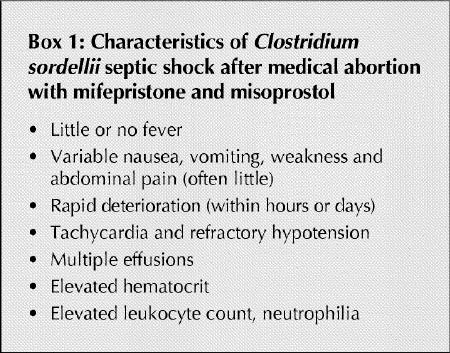Reason for posting: Mifepristone is used with misoprostol to terminate early pregnancies and has been taken by more than 460 000 women. The US Food and Drug Administration (FDA) recently advised of 4 women in the United States who died of sepsis after taking the drugs for medical abortion. Two of the women had Clostridium sordellii-related sepsis (www.fda.gov/cder/drug/advisory/mifeprex.htm). A Canadian woman died in 2001 of C. sordellii-related septic shock after taking the drugs in a clinical trial.1
The drugs: Mifepristone is a progesterone receptor antagonist and abortifacient, but was originally investigated for its antiglucocorticoid effects as a potential treatment for Cushing's syndrome. Widely used in Europe and the United States, it is not licensed for use in Canada. According to the FDA-approved protocol, 600 mg of mifepristone is taken orally within 49 days after the start of a woman's last menstrual period. Two days later 400 μg of the prostaglandin misoprostol is taken orally to soften the cervix and induce uterine contractions if the pregnancy has not already ended. Ten days later the woman is followed up clinically, often with ultrasonography, to confirm termination of her pregnancy. Complete medical abortion occurs in about 92% of women taking the regimen, but 5%–8% require a surgical procedure because of incomplete abortion, excessive bleeding or continuing pregnancy. Common adverse effects of the regimen include abdominal cramping and vaginal bleeding, headache, nausea and vomiting, and diarrhea. Rare but fatal cases of ruptured ectopic pregnancy have occurred. Mifepristone is metabolized in the liver by CYP3A4.
The 4 FDA-reported deaths occurred between 2003 and 2005 in California and involved women who had taken the misoprostol (800 μg) intravaginally. The infective agent was not identified in 2 of the cases. The patients with C. sordellii infection apparently had similar presentations (Box 1).
Box 1.

C. sordellii is a gram-positive anaerobe found ubiquitously in soil and as part of the human intestinal flora. Ten percent of women's vaginas are colonized. Infections are rare but have been reported in patients of all ages with both intact and compromised immune systems. Death is common, and the infections often occur after transcutaneous, perineal or gastrointestinal procedures.2 The organism produces an endotoxin and can produce 2 potent exotoxins. C. sordellii sepsis in mifepristone users may occur through effects on cortisol or cytokine responses.3
What to do: Women should be warned of this rare but potentially fatal adverse effect. They should seek immediate attention if they have fever, severe abdominal pain, very heavy bleeding, syncope or general malaise. However, clinicians must be aware that all of the deaths from C. sordellii sepsis reported here involved symptoms listed in Box 1. Prophylactic antibiotic therapy is not recommended for all women undergoing medical abortion; however, for those with suspected sepsis, complete blood counts and necessary cultures should be obtained and aggressive, empirical treatment with antibiotics started that includes coverage against C. sordelli.
Sally Murray Editorial Fellow Eric Wooltorton Associate Editor CMAJ
Footnotes
Early release
All Health and Drug Alerts are posted online ahead of print and are available at www.cmaj.ca. This article was posted on Aug. 10, 2005.
References
- 1.Sinave C, Le Templier G, Bluin D, Leville F, Deland E. Toxic shock syndrome due to Clostridium sordellii: a dramatic postpartum and postabortion disease. Clin Infect Dis 2002;35:1441-3. [DOI] [PubMed]
- 2.Abdulla A, Yee L. The clinical spectrum of Clostridium sordellii bacteraemia: two case reports and a review of the literature. J Clin Pathol 2000;53:709-12. [DOI] [PMC free article] [PubMed]
- 3.Miech RP. Pathophysiology of mifepristone-induced septic shock due to Clostridium sordellii. Ann Pharmacother 2005 Jul 26 [Epub ahead of print]. DOI 10.1345/aph.1G189. [DOI] [PubMed]


